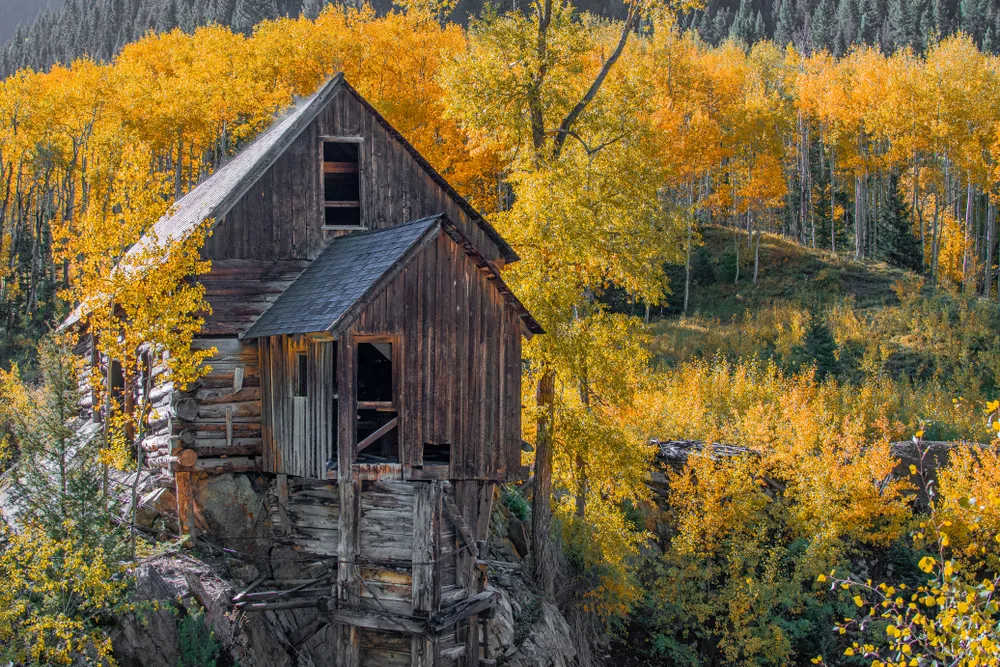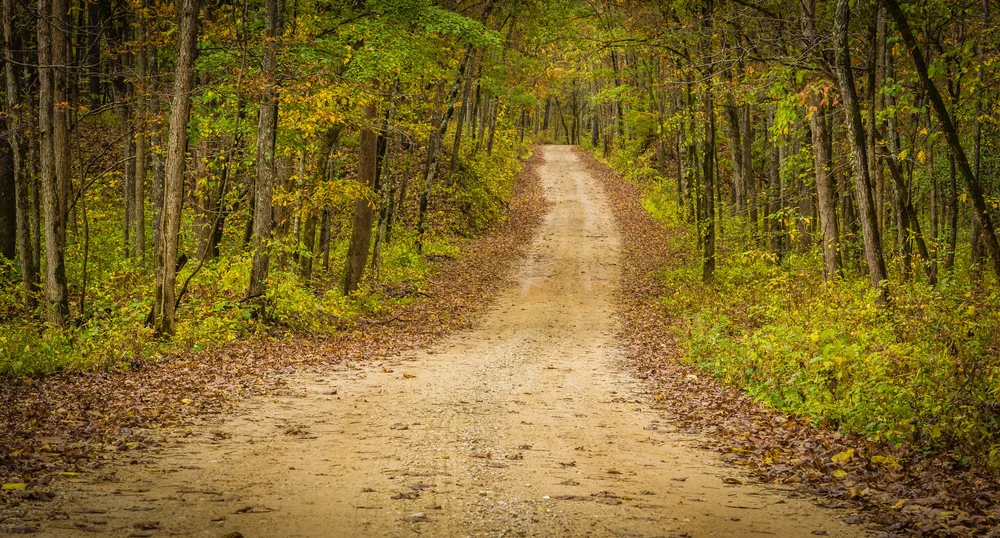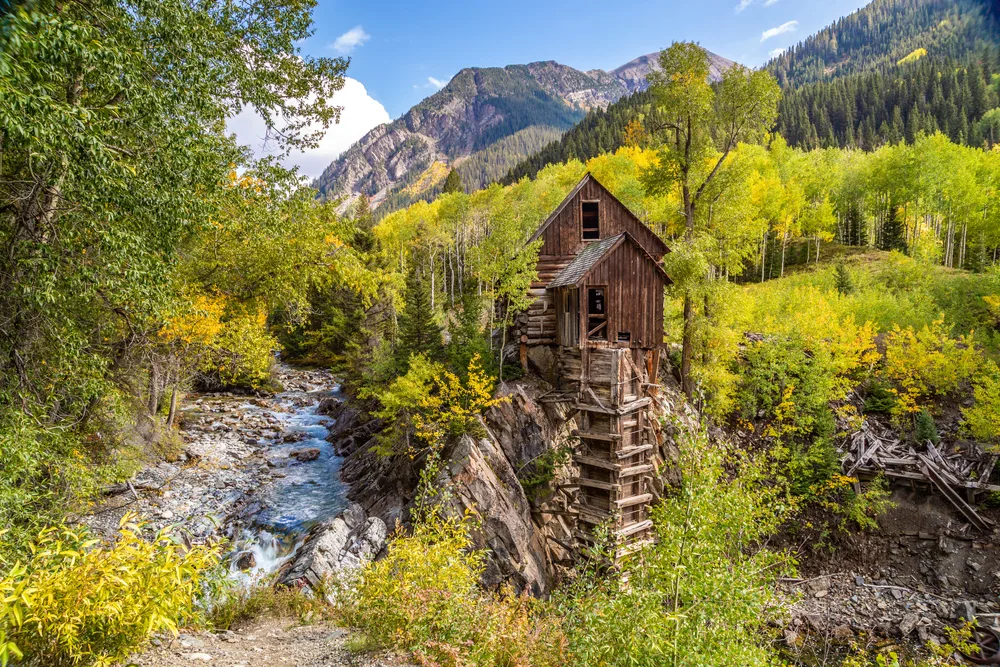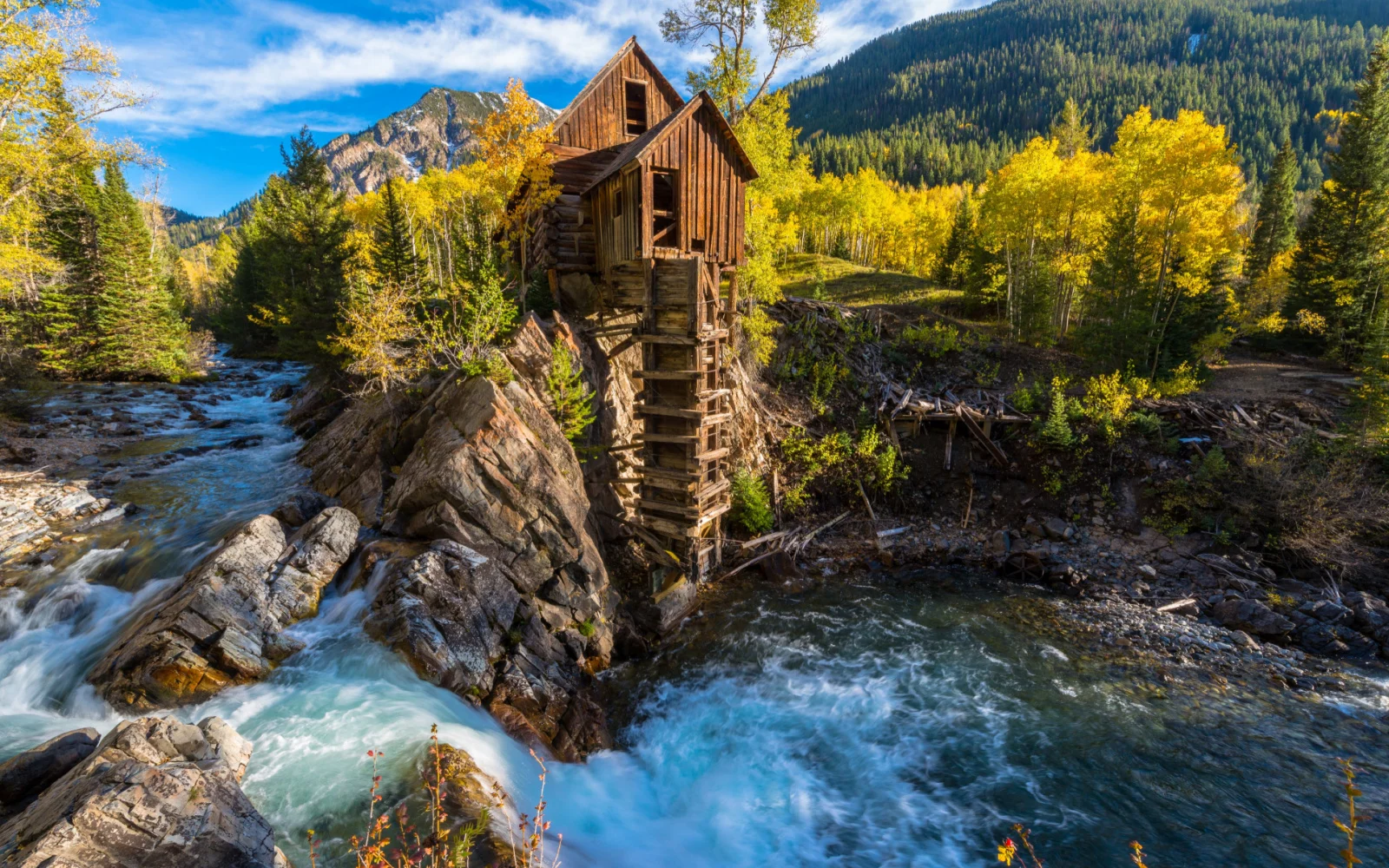Chances are, at some point in your lifetime, you’ve seen a picture of Crystal Mill and didn’t even know it. The old wooden building, perched high above a burbling aquamarine river, with a laddered chute leading down to the water’s edge, is a classic shot.
You’ll find it in restaurants, hotels, and offices across America, most commonly featuring the bright yellow and orange leaves that appear in autumn.
It’s a picture worth treasuring, and many outdoor enthusiasts and photography buffs want to get their own. Good news! If you’re planning to be in the Carbondale area, it’s an easy stopover.
If you just want an amazing adventure, then put the White River National Forest – gorgeous in its own right, especially in fall – on your itinerary as well.
In today’s post, we’re taking a look at the history of Crystal Mill, the logistics of getting there and photographing it, and some must-know changes about the area.
What Is Colorado’s Crystal Mill?

davisdeatonphotography/Shutterstock
Originally built in 1893, Crystal Mill served power to the town of Crystal, Colorado for years, generating it from the turbulent river below it. It sits on an outcrop of the Crystal River, with a long tube down to the base where the water flows.
Citizens of the mining boom town, which at one point boasted a population of around 500, used it to cool the nearby mines and power their tools.
The town also had saloons, a pool hall, stores, and its own newspaper, The Silver Lance. Today, the zinc, silver, and lead mines are all closed and have been for more than 100 years.
However, the town and “mill” (more properly known as a power generating station) still sit there, with weathered wood lending testament to the long passage of time.
Why See the Mill?
So, why put the mill on your agenda? The most compelling reason photographs have sought it out for decades is its serene but creepy beauty. One can tell just by looking at it that in its heyday, it was an object of pride and usefulness for those nearby.
In modern times, though, it’s just another piece of proof that America’s many and varied mining rushes are over. Heady nostalgia always makes for a great photo, right?
Moreover, the inherent precariousness of its position atop the outcrop makes clear that it will not stand forever, which motivates some people to get there and grab their pic while they still can. Plus, it’s quite simply a lovely shot.
Framed by trees, mountains, and sky on top, with cliffs and rivers below it, you’ll have no trouble getting a passable photo.
Yet photography nuts love it for the challenge it presents in taking pictures at different times of the day or capturing the inimitable quality of moving water.
How Do You Get There?

Lisa Fitzthum Photography/Shutterstock
Visitors can access Crystal Mill by heading along County Road 3 from Marble, Colorado. The mill is about 6 miles outside of town along a very rough stretch of road, suitable only for Jeeps and other offroad vehicles.
You can also hike in, but remember, you’ll have to hike out as well, and there is no camping allowed in the area. Strong hikers can do it, but prepare for a long day.
Bring plenty of food and water, dress in layers to account for the ever-shifting Colorado weather (yes, even in summer), and don’t forget your sunscreen. Jeep tours typically cost about $75 per person.
Photography Tips for Getting a Pro Shot
You can get a vibrant snap of Crystal Mill using only your smartphone. Today’s smartphones can take long-exposure (also known as slow-shutter) photos on your phone, which leaves the shutter open for seconds or minutes, allowing you to blur the water.
Two things to note about this:
- You’ll need a tripod. You cannot capture long-exposure photos by hand, because everything else will blur as well.
- You probably won’t be the only visitor during prime tourist season – summer and fall. The area sees thousands of visitors a week during this time, reports The Colorado Sun. So you’ll need to move quickly or others might get irritated.
Weatherwise, you can take a few approaches. One is to wait until late afternoon. Lighting conditions are lovely, lending a warm glow to the scene and making it easy to capture that Old West vibe for which many are shooting (no pun intended).
One caveat: don’t put it off until the typical “golden hour” just before sunset, because at that point the sun will have passed behind the mountains and you’ll lose much of the detail of the scene.
Although that might be a nice picture to capture as well, you’ll likely lose the impact. Another time that works out well is when the sky is overcast.
This is especially stunning when the trees are wearing their bright fall coat, because the absence of blue sky allows them to take center stage along with the mill. Lastly, bright clear days are also pretty.
The sun lights up the water below, giving your photo those prized turquoise and aquamarine shades. If you’d like a chance to photograph at multiple different times, you can always stay in nearby Marble.
Public Access Trail Closure: What You Need to Know

Marilyn D. Lambertz/Shutterstock
Due to poor behavior on the part of tourists, the trail leading to Crystal Mill – which for years funneled people down to the waterside beneath the mill – is now closed.
Owner Chris Cox has erased the trail, covered it with logs, and posted “No Trespassing” signs throughout the vicinity. The general store, which served up snacks and received the $10 trailhead fee, is also closed.
At the moment, it seems you can still drive along the road past the mill to the ghost town of Crystal, Colorado. There you’ll find a lodge, cabins, and some other structures. Please note that the cabins are actually rentals, so you cannot just wander into them.
Frequently Asked Questions
Here are a few frequently asked questions about the famous Crystal Mill:
Can you still take photos of the mill?
Yes, but you’ll have to do it from the road. The beach below the mill is no longer accessible on foot.
Are photos from the road worth it?
Photos from the road are still beautiful, capturing the Colorado essence of the scene: mill, river, trees, mountains, and sunny skies.
Should I take a tour?
If you have a 4WD or AWD vehicle with high clearance, you can drive up to the mill yourself. If you do not, a tour is required unless you want to hike in from the town of Marble 5.6 miles away.
Does it cost anything to see Crystal Mill?
Now that you don’t have to pay for trail access, it doesn’t cost anything to photograph the mill from across the road – unless, as mentioned, you have to pay for a vehicle tour.
How do I respect Crystal Mill and surrounding areas?
The reason the trail got closed is because too many people left trash, violated nearby cabins, or threw parties near this piece of history.
The best way to ensure future generations get to take their own photographs is to leave no trace, have your experience, and return home as quietly as you came!
Remember that the Marble is home to people (not ghosts!) who have a life to lead beyond accommodating tourists who just want a snapshot. Drive slowly through town, don’t leave vehicles to idle, and maintain a quiet composure.
Add Crystal Mill to Your Colorado Bucket List Today
While the destination may have taken a different shape in recent years, Crystal Mill is still a worthwhile item to put on your tourist agenda. Enjoy, and bring back a worthy picture to share with the class. Happy travels!



